Abstract
The recent appearance of an avian influenza A virus in seals suggests that viruses are transmitted from birds to mammals in nature. To examine this possibility, avian viruses of different antigenic subtypes were evaluated for their ability to replicate in three mammals-pigs, ferrets, and cats. In each of these mammals, avian strains replicated to high titers in the respiratory tract (10(5) to 10(7) 50% egg infective doses per ml of nasal wash), with peak titers at 2 to 4 days post-inoculation, similar to the pattern of human and other mammalian viruses in these animals. Most avian strains were recovered for 5 to 9 days post-inoculation. One avian H1N1 virus initially replicated poorly in pigs, but was adapted to this host and even transmitted to other pigs. Replication of the avian viruses occurred in the respiratory tracts of mammals, whereas, in birds, they replicate in the intestinal tract as well. The infected mammals had no significant disease signs and produced low levels of humoral antibodies; however, challenge experiments in ferrets indicated that they were immune. These studies suggest that influenza A viruses currently circulating in avian species represent a source of viruses capable of infecting mammals, thereby contributing to the influenza A antigenic pool from which new pandemic strains may originate.
Full text
PDF

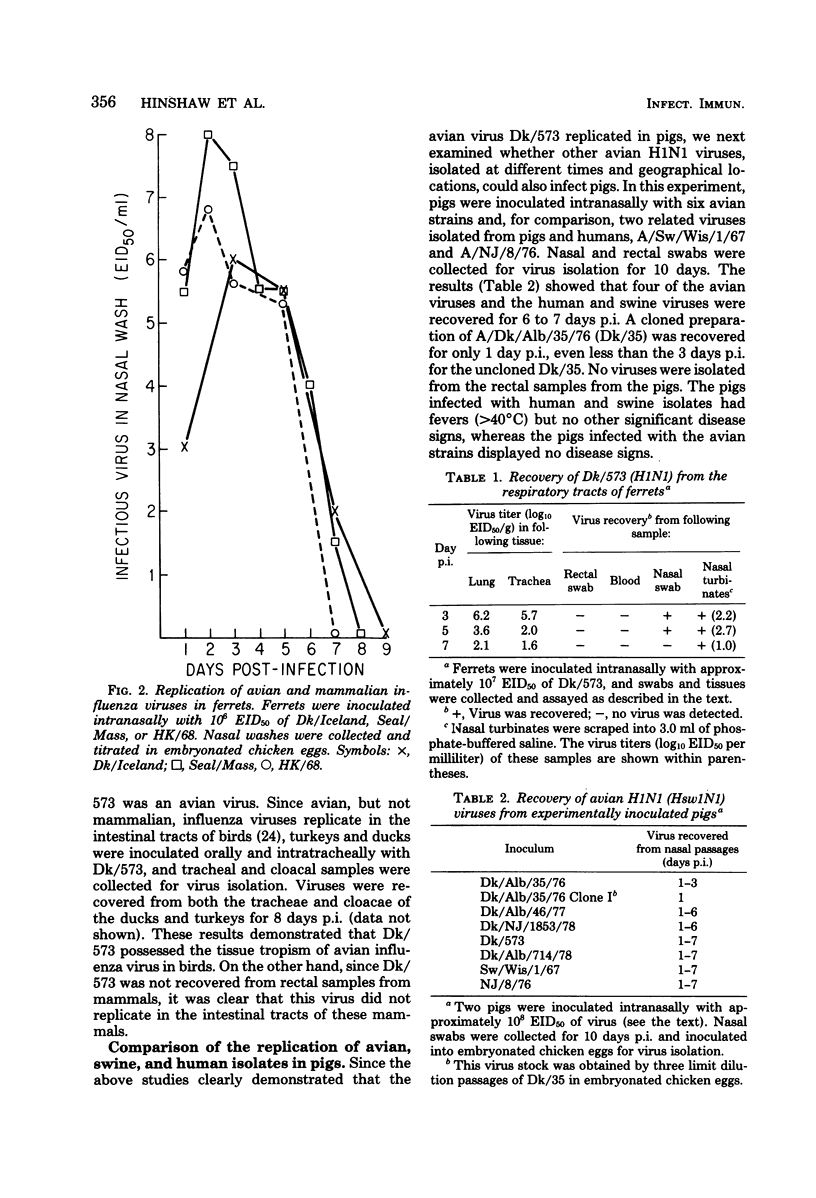
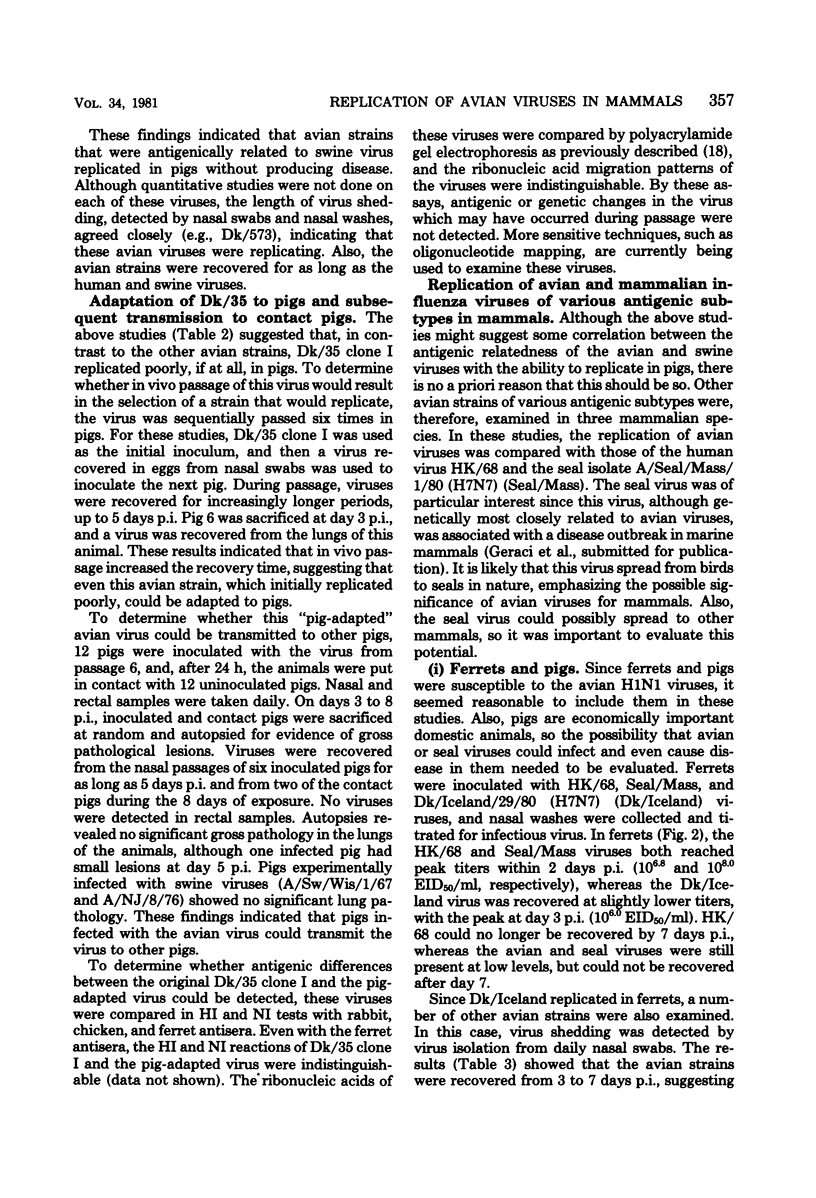
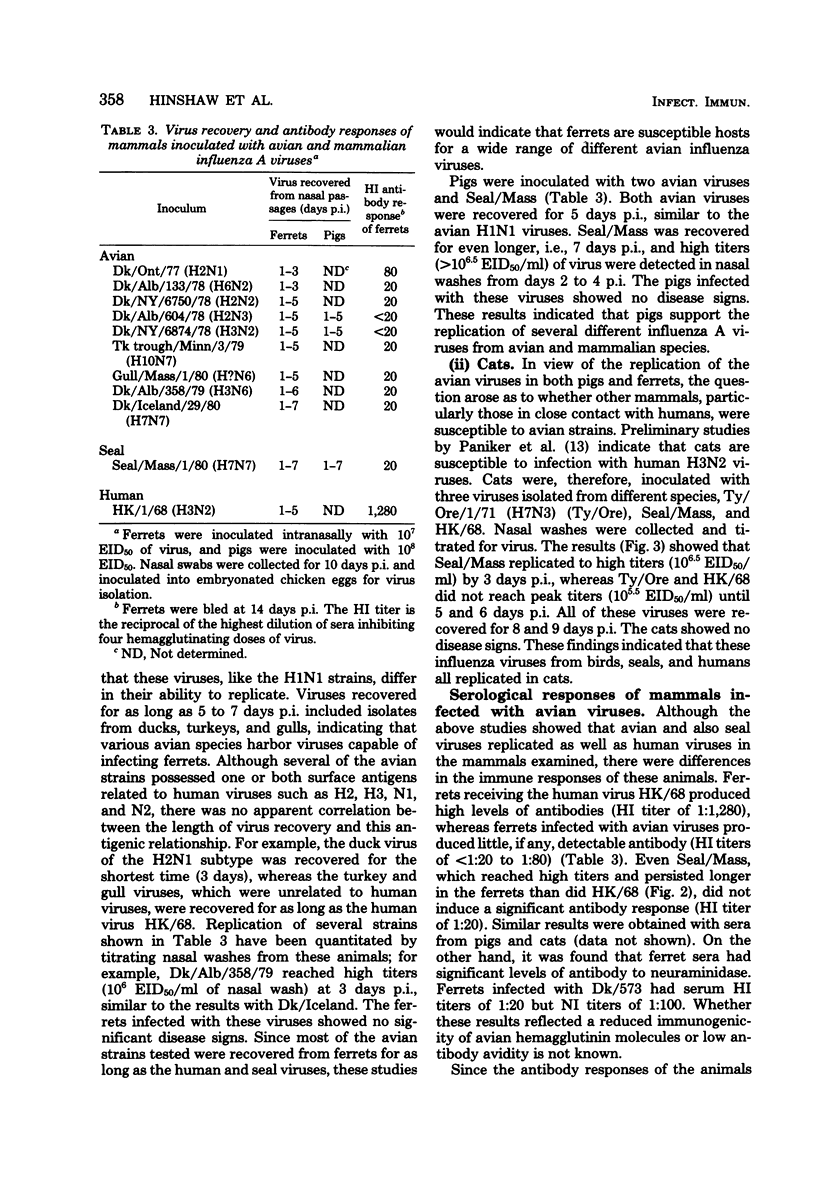
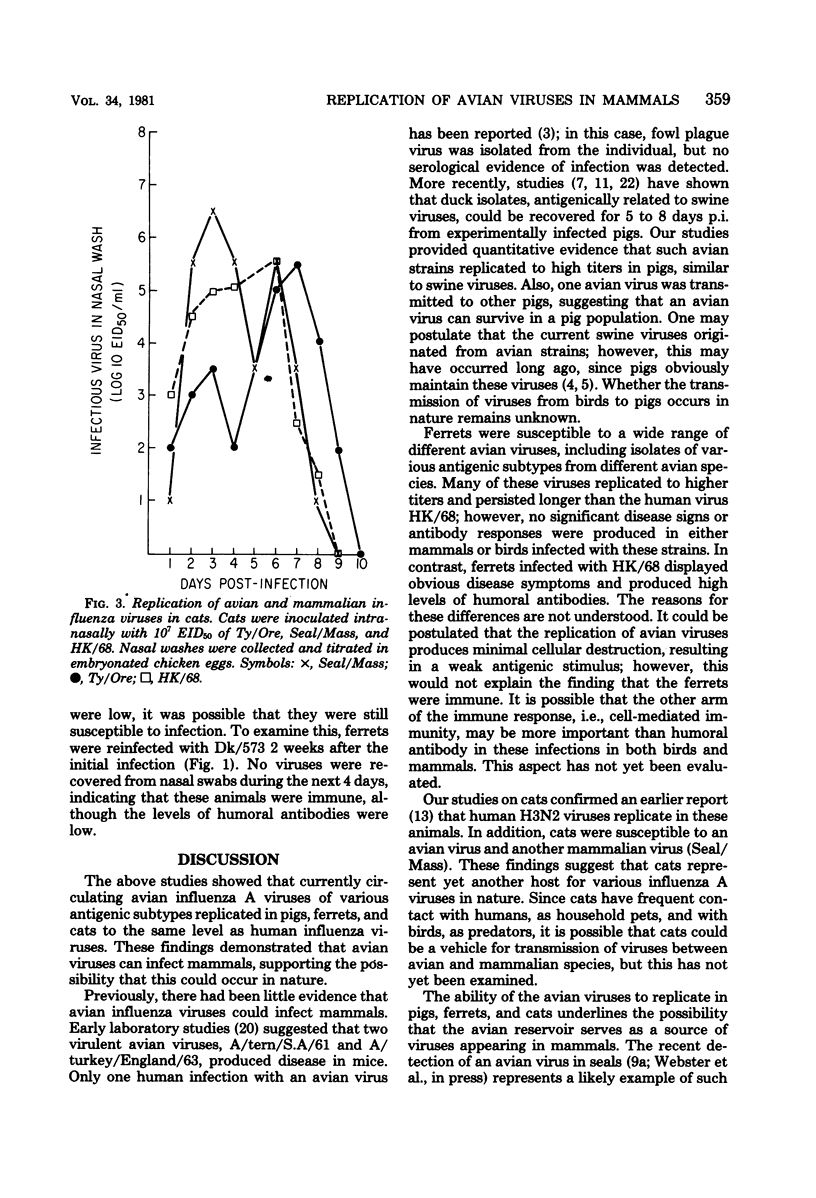
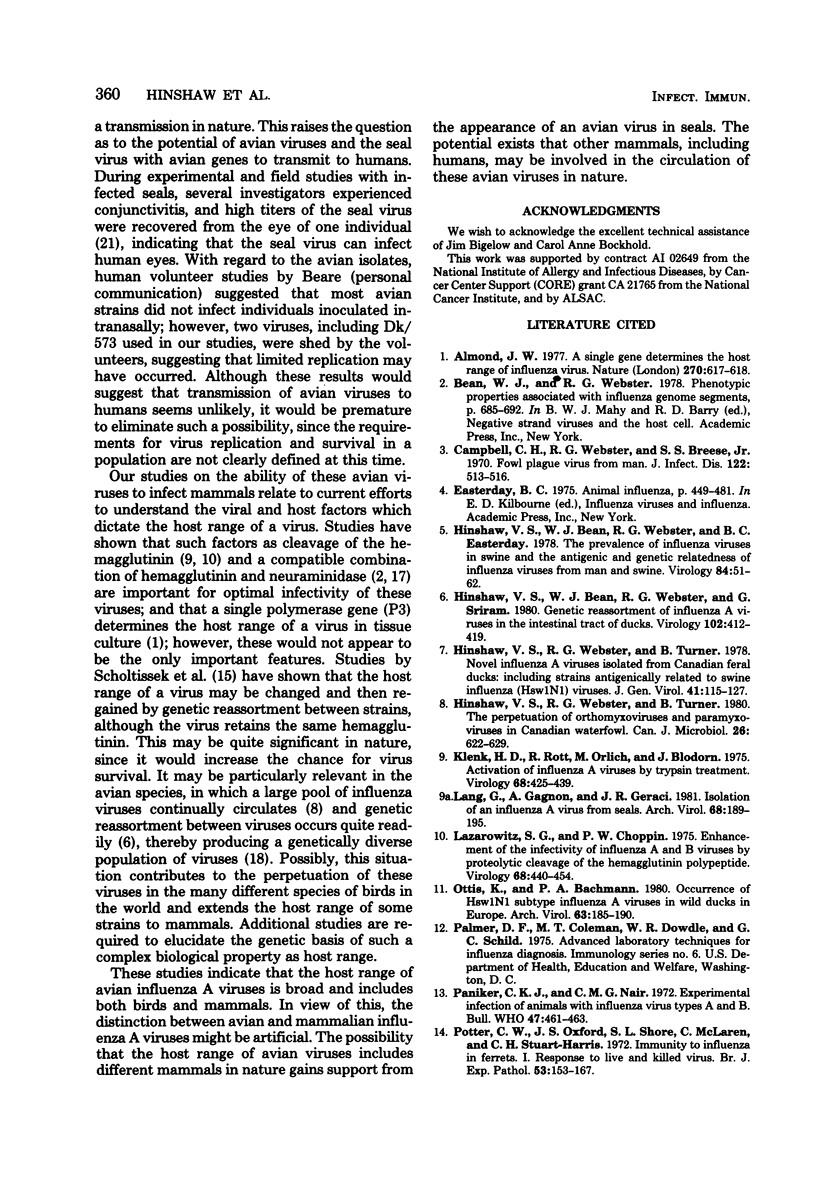

Selected References
These references are in PubMed. This may not be the complete list of references from this article.
- Almond J. W. A single gene determines the host range of influenza virus. Nature. 1977 Dec 15;270(5638):617–618. doi: 10.1038/270617a0. [DOI] [PubMed] [Google Scholar]
- Campbell C. H., Webster R. G., Breese S. S., Jr Fowl plague virus from man. J Infect Dis. 1970 Dec;122(6):513–516. doi: 10.1093/infdis/122.6.513. [DOI] [PubMed] [Google Scholar]
- Hinshaw V. S., Bean W. J., Jr, Webster R. G., Easterday B. C. The prevalence of influenza viruses in swine and the antigenic and genetic relatedness of influenza viruses from man and swine. Virology. 1978 Jan;84(1):51–62. doi: 10.1016/0042-6822(78)90217-9. [DOI] [PubMed] [Google Scholar]
- Hinshaw V. S., Bean W. J., Webster R. G., Sriram G. Genetic reassortment of influenza A viruses in the intestinal tract of ducks. Virology. 1980 Apr 30;102(2):412–419. doi: 10.1016/0042-6822(80)90108-7. [DOI] [PubMed] [Google Scholar]
- Hinshaw V. S., Webster R. G., Turner B. Novel influenza A viruses isolated from Canadian feral ducks: including strains antigenically related to swine influenza (Hsw1N1) viruses. J Gen Virol. 1978 Oct;41(1):115–127. doi: 10.1099/0022-1317-41-1-115. [DOI] [PubMed] [Google Scholar]
- Hinshaw V. S., Webster R. G., Turner B. The perpetuation of orthomyxoviruses and paramyxoviruses in Canadian waterfowl. Can J Microbiol. 1980 May;26(5):622–629. doi: 10.1139/m80-108. [DOI] [PubMed] [Google Scholar]
- Klenk H. D., Rott R., Orlich M., Blödorn J. Activation of influenza A viruses by trypsin treatment. Virology. 1975 Dec;68(2):426–439. doi: 10.1016/0042-6822(75)90284-6. [DOI] [PubMed] [Google Scholar]
- Lang G., Gagnon A., Geraci J. R. Isolation of an influenza A virus from seals. Arch Virol. 1981;68(3-4):189–195. doi: 10.1007/BF01314571. [DOI] [PubMed] [Google Scholar]
- Lazarowitz S. G., Choppin P. W. Enhancement of the infectivity of influenza A and B viruses by proteolytic cleavage of the hemagglutinin polypeptide. Virology. 1975 Dec;68(2):440–454. doi: 10.1016/0042-6822(75)90285-8. [DOI] [PubMed] [Google Scholar]
- Ottis K., Bachmann P. A. Occurrence of Hsw 1 N 1 subtype influenza A viruses in wild ducks in Europe. Arch Virol. 1980;63(3-4):185–190. doi: 10.1007/BF01315025. [DOI] [PubMed] [Google Scholar]
- Paniker C. K., Nair C. M. Experimental infection of animals with influenzavirus types A and B. Bull World Health Organ. 1972;47(4):461–463. [PMC free article] [PubMed] [Google Scholar]
- Potter C. W., Oxford J. S., Shore S. L., McLaren C., Stuart-Harris C. Immunity to influenza in ferrets. I. Response to live and killed virus. Br J Exp Pathol. 1972 Apr;53(2):153–167. [PMC free article] [PubMed] [Google Scholar]
- Scholtissek C., Rohde W., Von Hoyningen V., Rott R. On the origin of the human influenza virus subtypes H2N2 and H3N2. Virology. 1978 Jun 1;87(1):13–20. doi: 10.1016/0042-6822(78)90153-8. [DOI] [PubMed] [Google Scholar]
- Schulman J. L., Palese P. Virulence factors of influenza A viruses: WSN virus neuraminidase required for plaque production in MDBK cells. J Virol. 1977 Oct;24(1):170–176. doi: 10.1128/jvi.24.1.170-176.1977. [DOI] [PMC free article] [PubMed] [Google Scholar]
- Sriram G., Bean W. J., Jr, Hinshaw V. S., Webster R. G. Genetic diversity among avian influenza viruses. Virology. 1980 Sep;105(2):592–599. doi: 10.1016/0042-6822(80)90059-8. [DOI] [PubMed] [Google Scholar]
- Uys C. J., Becker W. B. Experimental infection of chickens with influenza A-Tern/South Africa/1961 and Chicken/Scotland/1959 viruses. II. Pathology. J Comp Pathol. 1967 Apr;77(2):167–173. doi: 10.1016/0021-9975(67)90007-2. [DOI] [PubMed] [Google Scholar]
- Webster R. G., Geraci J., Petursson G., Skirnisson K. Conjunctivitis in human beings caused by influenza A virus of seals. N Engl J Med. 1981 Apr 9;304(15):911–911. doi: 10.1056/NEJM198104093041515. [DOI] [PubMed] [Google Scholar]
- Webster R. G., Hinshaw V. S., Bean W. J., Sriram G. Influenza viruses: transmission between species. Philos Trans R Soc Lond B Biol Sci. 1980 Feb 25;288(1029):439–447. doi: 10.1098/rstb.1980.0021. [DOI] [PubMed] [Google Scholar]
- Webster R. G., Yakhno M., Hinshaw V. S., Bean W. J., Murti K. G. Intestinal influenza: replication and characterization of influenza viruses in ducks. Virology. 1978 Feb;84(2):268–278. doi: 10.1016/0042-6822(78)90247-7. [DOI] [PMC free article] [PubMed] [Google Scholar]


